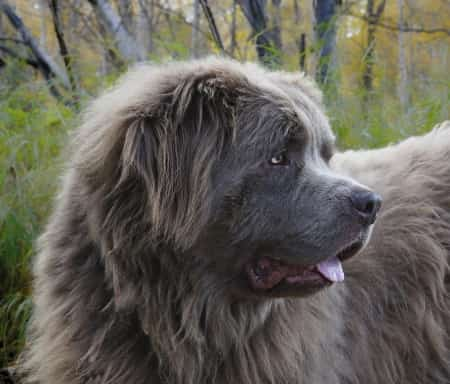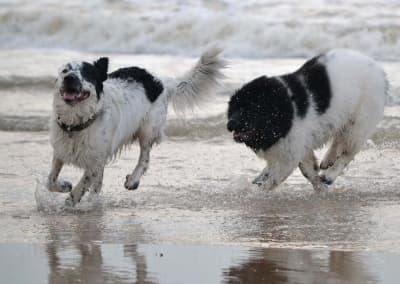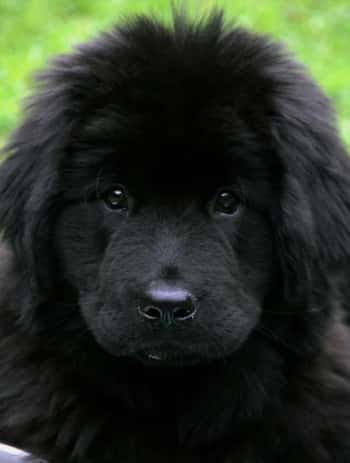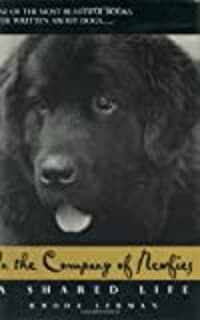Landseer Newfoundland
A Renowned Lifeguard!
When it comes to the origins of the Landseer Newfoundland, there is a fair amount of speculation about the breed's history, but not much evidence to support any one opinion.
That being said, most researchers agree that the place of his origin is the Canadian island of Newfoundland and that he has existed there for around two hundred years or more.

Whereas, the Landseer Newfoundland is a separately recognized breed in
Europe, otherwise known as the Landseer ECT, he is categorized in the US
and Great Britain along with the Newfoundland dog breed as being one and the same.
The main differences noted between the two are in relation to coat color
and height, plus the Landseer is said to be more energetic. Of course
their name differentiates them as well, the Landseer having acquired its
name from the great painter Sir Edwin Landseer who depicted the breed
in many of his paintings.

GPS Tracking Collar For Sporting Dogs
Most fanciers believe that the original stock of the Landseer dogs were transported from Europe to
Newfoundland aboard fishing boats. Once there they became working dogs on the shores using their great strength
to help pull in the fisherman's nets or haul needed supplies.
The Landseer Newfoundland is a tall and powerful dog. Their legs support
great balance and an elegant appearance. They are agile animals with a
short and square muzzle. Their ears are shaped in a triangular pendant.
Their eyes are dark brown with a black nose.
The breed has great swimming ability which is aided in part by its webbed feet.
Getting To Know The Landseer Newfoundland
The Landseer Newfoundland is frequently described as being a happy dog of excellent temperament.
He is also known to be very intelligent, generous and courageous.
With those kind of attributes, it's not surprising that he is an
exceptional family dog that is very sociable and enjoys the
companionship
of his pack a great deal.
While family come first, guests can also expect a friendly and respectful greeting when it is clear
they are welcome.
 Newfy Fun
Newfy FunThe Newfoundland dog breed is also diligent when it comes to guarding
his people. If the situation arises where they encounter an intruder,
they will usually act as a barrier between themselves and their family,
rather than resort to barking at them.
They also have the ability to recognize dangerous situations that may put their family at risk, but for friendly visitors
who present no threat, they are mild and calm.
They are sensitive to the sound of their owner's voice and will respond to training when presented in a calm, but firm manner.
Training that revolves around water is sure to he a hit. The Landseer is a renowned lifeguard - stories abound about
the number of people - and even other dogs, he has saved by pulling them to shore from perilous situations in the water.
Health Profile
The Landseer Newfoundland, can live up to 10 years or more with dedicated care, plus a nutritious well-balanced diet and regular oversight by a veterinarian.
The Newfy is susceptible to a few health
problems, especially if they become overweight.
- The main condition they are prone to is heart disease which is hereditary as well as hip dsyplasia.
- Puppies should be checked for sub-aortic stenosis once they reach eight to twelve weeks old. Adults should not be allowed to breed until they have been cleared for this.
- Bloat can also be a issue with the Newfoundland dog breed. To protect against this, pet parents can divide their dog's food up into smaller meals to reduce the risk.
If you are interested in obtaining a Newfoundland, find a responsible breeder and make sure these health tests recommended Breed Club have been completed:
- Hip Evaluation
- Cystinuria (Newfoundland) - DNA Test
- Hearts – auscultation or echo by a Board Certified Cardiologist
The Club also recommends these additional tests:
- Eyes by a Board Certified Ophthalmologist
- Patella palpation
- Thyroid – blood test
The Newfoundland Club of America has even more information to complete your research into the breed and is well worth a visit to their website.
Physical Stats
The male Landseer Newfoundland is typically 28 to 30 inches in height while the female Landseer Newfoundland is
typically 26 to 28 inches in height.
The males will weigh an average of 130 to 150 pounds while the females weigh between 100 to 120 pounds.
This very large dog has a gentle ambiance about him that is very reassuring. Much like the St. Bernard, you get the
feeling that he would come to your aid if needed. Solid in appearance, big boned and strong, he
typifies the ideal physical characteristics of a working dog.
 Newfoundland Puppy
Newfoundland PuppyCoat and Care
The coat of the Landseer Newfoundland is predominently white, broken by patches of black throughout the body.
The collar, belly, chest, and legs are white while the head is often black.
The double coat is water-repellent and lies flat. The undercoat is soft and dense while the outer coat is a more
coarse texture, but soft to the touch. A dog that spends more time indoors will likely lose the undercoat over time.
Frequent brushing is needed to maintain the coat and keep it free of
mats and tangles. During the times of heavy seasonal shedding the
brushing frequency needs to be stepped up. The FURminator is an excellent tool to remove dead hair from such a full-coated dog breed.
The LN should only be bathed as necessary so as not to strip the natural oils from the coat
which provide the waterproof protection. Use of dry shampoo is an alternate option.
Along with coat maintenance, nails should be inspected for necessary grinding or clipping. Ear inspection and cleaning
is important to all dogs, but even more so to dogs that spend a lot
of time in the water such as the Landseer.
It is a also a good idea to give your dog an overall pet checkup once a week -
you can find out how to do that here.
Exercise and Activity
These dogs thoroughly enjoy swimming and the outdoors. This is the ultimate exercise if you have access to areas where dogs can
swim safely.
As an alternate to water activities, or in addition to, longish daily
walks are a good option, plus every dog needs leash training. This
is a good way/time to work on establishing your leadership which is very
necessary with large dogs.
The age and health of the dog should always be kept in mind in selecting the level of exercise activities.
Books of Note About Newfoundlands
What's the Ideal Environment For a Newfy?
If you live in a cool climate, your Landseer will be more comfortable, happy and grateful! If you live near bodies
of water, he will be ecstatic. A spacious house is more suitable than an apartment.
Landseers are not very active indoors, so access to a shady yard for
fresh air, a little play and some training sessions would be
ideal.
The Newfoundland With Children?
Landseer dogs have a good reputation as being gentle and protective playmates with children, but if you have
very small children you might want to keep in mind that this is a big powerful dog that could accidentally knock
them over.
Aside from that note, this dog seems pretty bulletproof unless a child should do something out of the ordinary
to injure it that may cause an out-of-character reaction from the dog.
Even after teaching a child the proper way to interact with pets, supervision by an adult is still the best policy whenever
they are together because both children and pets can be unpredictable.
Companion For Senior Or Less Active?
Landseer Newfoundland dogs provide extremely good service in therapy situations.
However, while seniors might find their presence reassuring, taking care of one in the home, is another matter. This would also be true for less active families.
Before You Go...
If you like the content of this page, as well as others on my site, please give it some love by clicking on the heart in the lower right hand corner. This helps me keep providing enjoyable and useful content.
Thank you.



